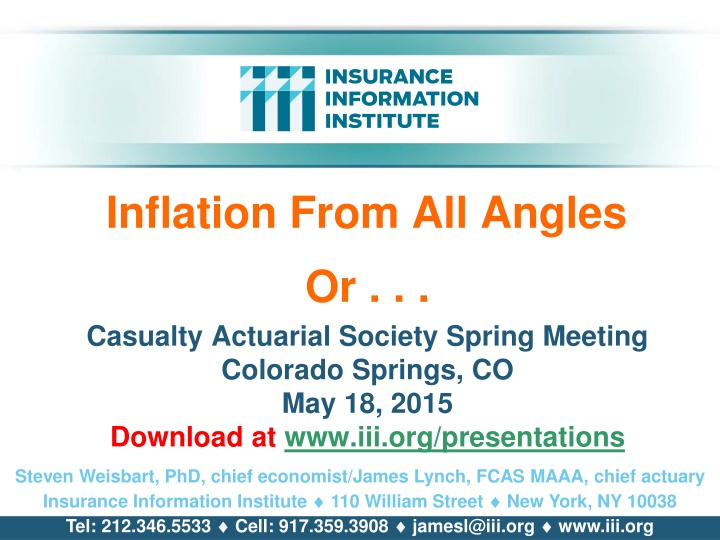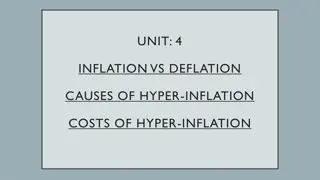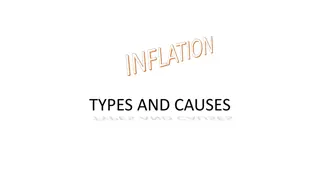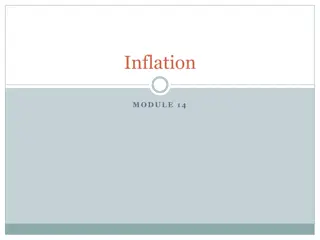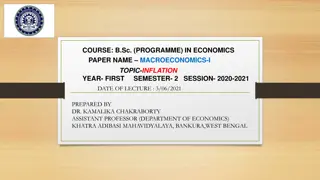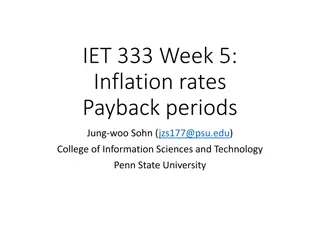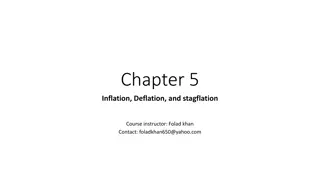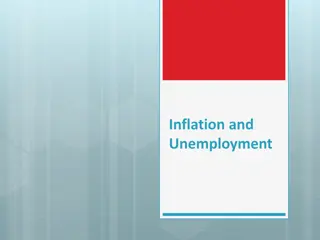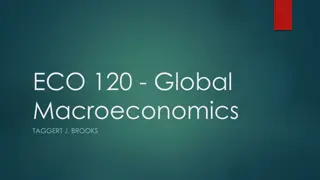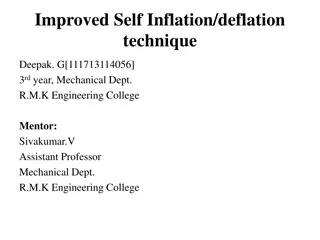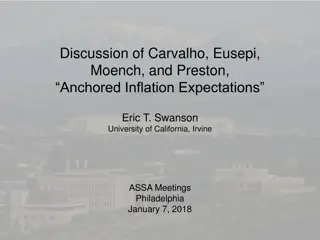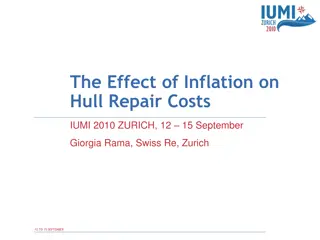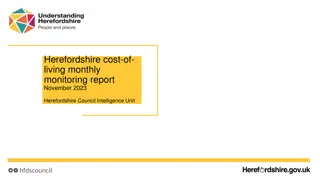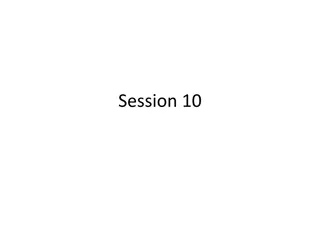Insights on Inflation Trends and Measures
Dive into a collection of visuals and analyses on inflation trends and measures, including past and present data on Consumer Price Index, Billion Prices Project findings, and Core PCE Price Index adjustments. Explore the nuances of inflation from various angles through engaging presentations from industry experts.
Download Presentation

Please find below an Image/Link to download the presentation.
The content on the website is provided AS IS for your information and personal use only. It may not be sold, licensed, or shared on other websites without obtaining consent from the author.If you encounter any issues during the download, it is possible that the publisher has removed the file from their server.
You are allowed to download the files provided on this website for personal or commercial use, subject to the condition that they are used lawfully. All files are the property of their respective owners.
The content on the website is provided AS IS for your information and personal use only. It may not be sold, licensed, or shared on other websites without obtaining consent from the author.
E N D
Presentation Transcript
A Bunch of Inflation-Related Stuff We Thought Was Interesting Or . . . Casualty Actuarial Society Spring Meeting Colorado Springs, CO May 18, 2015 Download at www.iii.org/presentations Inflation From All Angles Steven Weisbart, PhD, chief economist/James Lynch, FCAS MAAA, chief actuary Insurance Information Institute 110 William Street New York, NY 10038 Tel: 212.346.5533 Cell: 917.359.3908 jamesl@iii.org www.iii.org
Whats the Best Way to Measure Past Inflation? 2
Change* in the Consumer Price Index, 2004 2015 6% For two months in 2008, led by gasoline, the general price level was rising at a 5.5% pace Recession CPI Core CPI Lately, core CPI is rising at a 1.8% y-o-y pace 4% 2% 0% When gas prices dropped, the general price level was briefly lower than a year prior -2% '04 '05 '06 '07 '08 '09 '10 '11 '12 '13 '14 '15 Over the last decade, prices generally rose about 2% per year. *Monthly, year-over-year, through March 2015. Not seasonally adjusted. Sources: US Bureau of Labor Statistics; National Bureau of Economic Research (recession dates); Insurance Information Institutes. 3 3
The Billion Prices Project Tracks Daily Price Changes for Internet Purchases Source: http://blogs.wsj.com/economics/2015/03/13/the-billion-prices-project-thinks-inflation-may-have-turned-a-sharp-corner/ 4
Change* in the Consumer Price Index and Core CPI, 1990 2014, Semi-annually 6% For a half year at a time, the Core CPI has generally stayed within a range of 2% - 2.5% since 1997 Recession CPI Core CPI 5% 4% 3% 2% 1% 0% -1% 1990:1H 1991:1H 1992:1H 1993:1H 1994:1H 1995:1H 1996:1H 1997:1H 1998:1H 1999:1H 2000:1H 2001:1H 2002:1H 2003:1H 2004:1H 2005:1H 2006:1H 2007:1H 2008:1H 2009:1H 2010:1H 2011:1H 2012:1H 2013:1H 2014:1H Over the last 18 years, prices generally rose about 2% per year. *Semi-annually, through 2014:2H. Not seasonally adjusted. Sources: US Bureau of Labor Statistics; National Bureau of Economic Research (recession dates); Insurance Information Institute. 5 5
The PCE Deflator The y-o-y core PCE price index has stayed between 1% and 2% for 15 years 6
Y-o-Y Percent Change in Core PCE Price Index, Monthly, 2010 2015 2.5% Jan. 2012: 2.1% 2.0% 1.5% 1.0% 0.5% Dec. 2010: 0.9% 0.0% Jul-10 Jul-11 Jul-12 Jul-13 Jul-14 Jan-10 Jan-11 Jan-12 Jan-13 Jan-14 Jan-15 Oct-10 Oct-11 Oct-12 Oct-13 Oct-14 Apr-10 Apr-11 Apr-12 Apr-13 Apr-14 Apr-15 In December 2010, prices were falling. But the trend of price changes can change fairly quickly, even in a time of weak economic growth. Prices began rising in January 2011 and kept doing so for 13 months. Sources: U.S. Department of Commerce, Bureau of Economic Analysis, at http://www.bea.gov/iTable/iTable.cfm?reqid=12&step=1&acrdn=2#reqid=12&step=1&isuri=1 Table 2.4.4U Insurance Information Institute. 7
PCE Deflator: Goods vs. Services The price spike in 2011 was caused by a spike in the price of goods, while services prices were stable The price index for goods is much more volatile than the price index for services 8
Should We Focus on Price Changes in a More Granular Way? 10
Prices for Hospital Services: 12-Month Change,* 1998 2014 December 2014 Inpatient services +5.5% Outpatient services +4.5% 14% 12% 10% 8% 6% 4% 2% 0% '98 '99 '00 '01 '02 '03 '04 '05 '06 '07 '08 '09 '10 '11 '12 '13 '14 Recession Outpatient Services Inpatient Services Prices for Hospital Services have risen at an annual rate of 4% or more for the last 15 years, while the general price level rose by 2%/year. *Percentage change from same month in prior year; through December 2014; seasonally adjusted Sources: US Bureau of Labor Statistics; National Bureau of Economic Research (recession dates); Insurance Information Institute. 11
Constant Quality Price Index for Single Family Houses Under Construction, Monthly, 2006-2015 Price Index, Jan. 2005 = 100 Prices began dropping in April 2007 9 months before the Great Recession started Annual Price Changes 2006: +6.0% 2007: +0.9% 2008: -3.5% 2009: -5.0% 2010: -1.7% 2011: +1.0% 2012: +1.0% 2013: +6.5% 2014: +6.7% 120 115 110 105 100 The current rise began in Feb. 2012 95 Mar-06 Mar-07 Mar-08 Mar-09 Mar-10 Mar-11 Mar-12 Mar-13 Mar-14 Mar-15 Jun-06 Jun-07 Jun-08 Jun-09 Jun-10 Jun-11 Jun-12 Jun-13 Jun-14 Sep-06 Sep-07 Sep-08 Sep-09 Sep-10 Sep-11 Sep-12 Sep-13 Sep-14 Dec-05 Dec-06 Dec-07 Dec-08 Dec-09 Dec-10 Dec-11 Dec-12 Dec-13 Dec-14 Note: Recession indicated by gray shaded column. Price changes in 2015 are preliminary Sources: Census Bureau at https://www.census.gov/construction/cpi/ ; NBER (recession dates); I.I.I. 12
P/C Industry Homeowners Claim Frequency, US, 1997-2013 Claims Paid per 100 Exposures CAT-related claims Non-CAT-related claims All Claims 10 9.53 8.85 8.79 8.56 8 8.10 7.99 7.52 7.43 7.30 6.99 6.71 6.61 6.53 6.51 6.48 6.45 6.43 6.40 6.26 6 6.05 5.83 5.26 5.03 4.63 3.64 3.773.94 4.01 4.12 4.14 4.21 4 3.83 3.78 3.703.53 3.42 2.97 2.82 2.73 2.67 2.57 2.39 2.34 2.34 2.32 2.28 2 1.84 1.69 1.57 1.50 1.32 0 1997 1998 1999 2000 2001 2002 2003 2004 2005 2006 2007 2008 2009 2010 2011 2012 2013 Sources: Insurance Research Council, Trends in Homeowners Insurance Claims, p.41; Insurance Information Institute
P/C Industry Homeowners Average Claim Severity, Inflation-adjusted, 1997-2013 non-cat claims cat claims 2013 dollars $9,000 $8,000 $7,000 $6,000 Inflation-adjusted, HO average claim severity is now over twice what it was in 1997. $5,000 $4,000 $3,000 $2,000 1997 1998 1999 2000 2001 2002 2003 2004 2005 2006 2007 2008 2009 2010 2011 2012 2013 Sources: Insurance Research Council, Trends in Homeowners Insurance Claims, 2015 edition, p. 41; BLS inflation calculator, with Insurance Information Institute calculations
Price Changes for Nonresidential Maintenance & Repair, Monthly, 2010-2015 The effect of repair costs on claims depends on when the work is priced. Y-o-Y Price Changes 3.0% 2.7% 2.6% 2.5% 2.5% 2.3% 2.3% 2.2% 2.1% 2.1% 2.1% 2.1% 2.0% 2.0% 2.0% 2.0% 2.0% 1.9% 1.9% 1.9% 1.9% 1.8% 1.9% 1.8% 1.8% 1.8% 1.8% 1.8% 1.8% 1.8% 1.7% 1.7% 1.7% 1.7% 1.7% 1.6% 1.6% 1.6% 1.6% 1.5% 1.5% 1.5% 1.5% 1.5% 1.5% 1.4% 1.4% 1.4% 1.4% 1.4% 1.3% 1.3% 1.2% 1.2% 1.2% 1.2% Annual Price Changes 2011: +1.3% 2012: +1.4% 2013: +1.8% 2014: +2.2% 1.1% 1.1% 1.1% 1.1% 1.0% 1.0% 1.0% 0.9% 0.9% 0.5% 0.0% Jul 10 Jul 11 Jul 12 Jul 13 Jul 14 Jan 11 Jan 12 Jan 13 Jan 14 Jan 15 Prices for nonresidential maintenance & repair have been rising slowly since 2011. Price data for 2015 are preliminary. Sources: US Bureau of Labor Statistics, Producer Price Index Series Id: PCU2381MR2381MR; Insurance Information Institute 15
What about Wage Trends? Isnt that a Major Cause of Inflation? 16
Indexed Cost of Total Compensation per Hour Worked, Quarterly, 2004-2014 Recession CPI Index Index: 2004:Q1 = 100 135 130 125 120 115 Following 2008, compensation has grown slightly faster than the CPI 110 105 100 2004:Q1 2005:Q1 2006:Q1 2007:Q1 2008:Q1 2009:Q1 2010:Q1 2011:Q1 2012:Q1 2013:Q1 2014:Q1 Note: Recession indicated by gray shaded column. Sources: Bureau of Labor Statistics; NBER (recession dates); I.I.I. 17
Whats the Best Way to Forecast Future Inflation? 19
Inflation Forecasts in Econometric Models, 2015- 2020 but the FOMC is forecasting the PCE Inflation rate to be 0.6%- 0.8% in 2015, 1.7%-1.9% in 2016, and 1.9% to 2.0% in 2017. There seems to be general agreement: the CPI will rise by about 2.3% for the next 5 years 3.0% 2.4% 2.4% 2.4% 2.4% 2.4% 2.4% 2.3% 2.3% 2.3% 2.3% 2.3% 2.3% 2.3% 2.2% 2.2% 2.0% 2.1% 1.0% 0.3% 0.0% 2015 2016 2017 2018 2019 2020 2021 CBO OMB Blue Chip In the Blue Chip survey, the range of CPI forecasts for 2015 is -1.0% to +1.5%. For 2016 it is +1.0% to +3.2%. 20 Sources: Blue Chip Economic Indicators (3/2015 issue); Wells Fargo Economics Group Interest Rate Weekly, May 6, 2015; Insurance Information Institute
The Bond Markets Recent* Expectation of U.S. Inflation in the Next Five Years At the start of 2013 the bond market thought inflation was likely to rise at a 2.25% clip. Current expectations are for inflation over the next 5 years are near 1.75% per year. The chart was derived by subtracting the TIPS 5-year yield (which has no inflation component) from the yield for the 5-year U.S. Treasury note (which, at least in theory, includes anticipated inflation). Source: http://ycharts.com/indicators/5_year_tipstreasury_breakeven_rate ; I.I.I. 21
Has the Upward Inflation Spike Begun? Inflation by most measures has begun to move up again the past two months, following a string of negative readings that lasted through January. Source: Inflation: Back on Solid Ground? Wells Fargo Economics Group, Special Commentary, May 4, 2015; I.I.I. 22
Inflation and P/C Insurer Investments If Expected Inflation Remains Low, Will Bond Yields Be Mired at Levels Last Seen in the 1950s? 23
U.S. Treasury 2- and 10-Year Note Yields*: Monthly, 1990 2015 Yields on 10-Year U.S. Treasury Notes have been essentially below 5% for over a decade. U.S. Treasury 10-year note yields spiked Since roughly 80% of P/C bond/cash investments are in 10-year or shorter durations, most P/C insurer portfolios will have low-yielding bonds for years to come. *Monthly, constant maturity, nominal rates, through January 2015. Sources: Federal Reserve Bank at http://www.federalreserve.gov/releases/h15/data.htm. National Bureau of Economic Research (recession dates); Insurance Information Institutes. 24 24
New Money vs. Embedded Yields, U.S. Insurers, 1983-2012 Falling yields means less investment income, putting upward pressure on rates. As long as new money rates are below the rates of maturing bonds, the portfolio yield will continue to sink. Sources: NCCI, Insurance Information Institute. 25 25
Net Yield on P/C Insurer Invested Assets, 2007-2014:Q3 Since year-end 2007, P/C Insurer net yields dropped by 133 basis points. This downtrend is likely to continue as older, higher-yielding bonds mature and are replaced by lower-yielding ones. Sources: NAIC, via SNL Financial; I.I.I. 26
Distribution of Bond Maturities, P/C Insurance Industry, 2005-2014 2014 16.8% 30.8% 9.6% 37.1% 5.7% 2013 16.5% 29.3% 9.8% 38.8% 5.7% 2012 16.6% 27.6% 9.8% 40.4% 5.7% 2011 Under 1 year 15.2% 26.8% 10.3% 41.4% 6.3% 1-5 years 2010 16.3% 26.7% 11.1% 39.5% 6.4% 5-10 years 2009 16.2% 28.7% 11.7% 36.2% 7.3% 10-20 years over 20 years 2008 15.7% 31.2% 12.7% 32.4% 8.1% 2007 15.2% 33.8% 12.9% 30.0% 8.1% 2006 16.0% 34.1% 13.1% 29.5% 7.4% 2005 16.0% 34.1% 13.6% 28.8% 7.6% 0% 20% 40% 60% 80% 100% The main shift over these years has been from longer maturities to shorter maturities, but the 2013-14 data suggest a shift back has begun. The 2014 distribution resembles that at year-end 2009. Sources: SNL Financial; Insurance Information Institute. 27
Bonds Rated NAIC Quality Category 3-6 as a Percent of Total Bonds, 2003 2014 From 2006-07 to year-end 2012, the percentage of lower-quality bonds in P/C industry portfolios doubled 5.0% 4.36% 4.07% 3.99% 4.0% 3.10% 3.07% 3.0% 2.69% 2.58% 2.27% 2.17% 2.10% 2.04% 1.98% 2.0% 1.0% 0.0% 2003 2004 2005 2006 2007 2008 2009 2010 2011 2012 2013 2014:Q3 There are many ways to capture higher yields on bond portfolios. One is to accept greater risk, as measured by NAIC bond ratings. The ratings range from 1 to 6, with the highest quality rated 1. Even in 2014, over 95% of the industry s bonds were rated 1 or 2. Sources: SNL Financial; Insurance Information Institute.
Moodys AAA Seasoned Bond Yields vs. CPI, 1954-2014 15% 14% 13% 12% 11% The gap is narrowing 10% 9% 8% 7% 6% 5% 4% 3% 2% 1% 0% -1% 1954 1958 1962 1966 2000 2004 2008 2012 1956 1960 1964 1968 1970 1972 1974 1976 1978 1980 1982 1984 1986 1988 1990 1992 1994 1996 1998 2002 2006 2010 2014 Moody's AAA Seasoned Bond Yields CPI As a general rule, the CPI trend drives bond yields. Sources: BLS, https://research.stlouisfed.org/fred2/data/AAA.txt ; Insurance Information Institute. 30 30
What Inflation Doesnt Measure The Idea: Trend Inflation (And Always Will Be) 31
Case Study: Inflation in Auto Prices CPI-U: New Cars 150 1997 to Present: No Inflation 145 140 135 130 125 120 115 110 105 100 1984-1 1985-1 1986-1 1987-1 1988-1 1989-1 1990-1 1991-1 1992-1 1993-1 1994-1 1995-1 1996-1 1997-1 1998-1 1999-1 2000-1 2001-1 2002-1 2003-1 2004-1 2005-1 2006-1 2007-1 2008-1 2009-1 2010-1 2011-1 2012-1 2013-1 2014-1 According to Government, Auto Prices Have Been Flat for Nearly Two Decades. Not Seasonally Adjusted. 1982-84 = 100. Sources: Bureau of Labor Statistics, Insurance Information Institute. 32
Inflation in Auto Prices CPI-U: New Cars vs. New Car Expenditures BEA New Car Expenditure 200 Great Recession Which Is Better Trend Index? 190 180 Inflation Index 170 Basis of Settlement When Car Is Totaled 160 CPI-U New Cars 150 140 130 JAN- JAN- JAN- JAN- JAN- JAN- JAN- JAN- JAN- JAN- JAN- JAN- JAN- JAN- JAN- JAN- JAN- JAN- JAN- 97 98 99 00 01 02 03 04 05 06 07 08 09 10 11 12 13 14 15 According to Government, Auto Prices Have Been Flat for Nearly Two Decades. But New Car Expenditues Are Up 35%. Expenditure Indexed to CPI-New Autos as of January 1997. Not Seasonally Adjusted. For CPI, 1982-84 = 100. Sources: Bureau of Economic Analysis, Insurance Information Institute. 33
Auto Prices vs. Auto Inflation % Increase, 1990-2013 90.0% 81.0% 80.0% 67.6% 70.0% 60.0% 50.0% 40.0% 30.0% 20.0% 20.0% 10.0% 0.0% CPI-U All Items CPI-U New Car New Car Expenditure From 1990 to 2013, Actual New Car Prices Rose Three Times Faster Than New Car Inflation Rate. Not Seasonally Adjusted. 1982-84 = 100. Sources: Bureau of Economic Analysis; Bureau of Labor Statistics; Calculations by Insurance Information Institute. 34
Auto Prices vs. Auto Inflation % Increase New Car Prices CPI-U 160% Auto Price Increases Regularly Outstrip Inflation. 135% 140% 120% 109% 100% 82% 80% 72% 65% 60% 40% 33% 27% 24% 20% 12% 12% 8% 2% 0% 1950s 1960s 1970s 1980s 90-08 08-13 The Difference: Safety Improvements, Conveniences. Not Seasonally Adjusted. Sources: The People History; Bureau of Labor Statistics; Calculations by Insurance Information Institute. 35
BLS Quality Adjustments Safety Improvements Durability Airbags Stronger Bumpers Seatbelts Flexible Body Panels Mechanical/electrical Comfort/convenience Changes Braking Improvements Remote Door Locks Battery Life GPS Systems 36
Typical Adjustments (2013-14 Model Years) These All Affect Price of Car, But Not Auto CPI. No More 6-disk CD Player $(30) Remote Start (Made Standard) $60 HID Headlamps $120 Maintenance Changes $300 Warranty Changes $124 MPG Changes $22 Emissions Changes $84 Rear View Camera $120 Front Knee Airbag $80 $540 in Safety Changes. Lane Departure Warning $120 Brake Assist $40 Center Side Impact Air Bags $180 $(50) $- $50 $100 $150 $200 $250 $300 $350 Changes Above Would Increase Car Price By $1,220. CPI Impact 0%. Sources: Bureau of Labor Statistics, Insurance Information Institute. 37
Auto Price Change: Quality vs. Inflation $1,400 1,130 Quality Inflation $1,200 Value of Improvements > Change in Price, so Inflation is Negative. $1,000 $800 570 $600 443 441 384 318 311 $400 275 271 239 231 213 210 209 186 185 170 169 151 148 140 132 111 107 $200 98 95 90 83 75 63 48 29 25 16 $0 (13) -$200 (105) (106) (151) Model Year Sales Year Is to Model Year as Calendar Year Is to Policy Year Sources: Bureau of Labor Statistics, Insurance Information Institute. 38
Other Adjustments (A Quiz) It Doesn t Change PV(Car)! Counted As Inflation Not Counted As Inflation Adjustment Mix of Model Years Within Sales Year Environmental (Clean Air Regs.) Rebates Concessions (Negotiation) Low Interest Financing It s an Apples-to-Apples Comparison! It s A Pigovian Tax! Of Course It Is! Of Course It Is! 39
Inflation vs. Trend (The Sequel) The Idea: Trend Inflation (Except When It Isn t) 41
An Example: Homeowners Since 2009: 0.3 Points/Yr Above CPI. non-cat claims cat claims Paid Severity in 2013 dollars $10,000 $9,051 1997-2009: 6.8 Points/Year Above CPI. $8,633$8,527 $8,541$8,718$8,772 $9,000 $7,665 $8,222 $8,833 $8,823 $8,000 $8,034 $7,849 $7,614 $7,000 $7,331 $7,332 $6,637 $7,383 $7,039 $6,829 $6,134 $5,249 $6,679 $6,000 $7,444 $5,402 $5,000 $4,414 $5,041$4,965 $4,964 $3,932$4,032 $4,000 $4,755 $3,867 $4,435 $3,671 $3,000 1997 1998 1999 2000 2001 2002 2003 2004 2005 2006 2007 2008 2009 2010 2011 2012 2013 There Can Be Periods Where CPI > Severity Change. Sources: Insurance Research Council, Trends in Homeowners Insurance Claims, 2015 edition, p. 41; BLS inflation calculator, with Insurance Information Institute calculations
Another Example: WC Medical Average Annual Growth, 2002-09 WC Medical Severity: 6% Medical CPI: 4% But Since 2010 WC Medical Severity has Closely Tracked the Medical CPI 10% 9% 8.8% 8% 7.8% 7.7% 7% 6.8% 5.8%6.1% 4.4% 6% 5.4% 5% 4.7% 4.0% 3.5% 3.4% 4% 3.0% 4.4% 4.2% 4.0% 4.0% 3.0% 3% 3.7% 3.2% 3.0% 2.6% 2% 2.5% 2.4% 1.2% 1% 0% 2002 2003 2004 2005 2006 2007 2008 2009 2010 2011 2012 2013 2014 Sources: CPI and Med CPI from US Bureau of Labor Statistics, WC med severity from NCCI based on NCCI states.
Another Example: WC Indemnity Change in Median Usual Weekly Earnings Change in Indemnity Cost per Lost-Time Claim 12% 10.1% 9.2% 10% 9.1% 9.0% 10.1% Similar to Medical Benefits Suddenly Tracking Inflation 7.7% 8% 5.9%6.5% 5.9% 6% 4.6% 3.1% 5.0%4.9% 4% 3.1% 2.6% 4.0% 3.1%3.6%3.9% 2.0% 3.5% 2.9% 2% 2.4%1.1% 1.0% 2.3%2.7% 1.1%0.5% 1.7% 2.0%2.0% 1.2%1.6%1.0% 2.0% 1.0% 0% -2% -2.7% -4% 1996 2009 1995 1997 1998 1999 2000 2001 2002 2003 2004 2005 2006 2007 2008 2010 2011 2012 2013 NCCI data on WC severity is based on the states where NCCI provides ratemaking services. Excludes the effects of deductible policies. Sources: NCCI, BLS, from Current Population Survey.
And One Last Example: PD Liability Annual Change, 2005 through 2014 . . . And Diverged in 2013 Severity Converged in 2009 . . . Severity New Auto CPI 5% 4.2% 4% 3.6% 3.5% 3% 3.0% 2.9% 2% 2.0% 2.0% 1.8% 1.4% 1.0% 2.3% 0.9% 1% 1.0% 0.9% 0.4% 0.5% -0.4% -0.4% -0.3% 0% -0.3% 2005 2006 2007 2008 2009 2010 2011 2012 2013 2014 -1% Aftermath of Great Recession Source: ISO/PCI Fast Track data, Bureau of Labor Statistics, Insurance Information Institute. 45
How Could Inflation > Trend? Severity = Quality + Inflation Base Case: Severity > Inflation Severity < Inflation Implies . . . . . . Quality < 0.0 Are Cars Getting Worse? NAH!!!! Better Insurance Claims Control? Safer Cars Eliminate Expensive Claims? We Do Need to Think About Impact When Severity Inflation Will It Diverge Again? 46
What About Loss Reserves? The Idea: Inflation Lags Long-Term Average, And So Does Loss Trend 51
Loss Development Factors Age to Age Reported Loss Development Factors - P&C Industry 12 - 24 Months 24 - 36 Months 36 - 48 Months 48 - 60 Months 60 - 72 Months 72 - 84 Months 84 - 96 Months 96 - 108 Months 1.0756 1.0529 1.0525 1.0552 1.0675 1.0672 108 - 120 Months 1.0517 1.0307 1.0516 1.0406 1.0535 Accident Year 2001 2002 2003 2004 2005 2006 2007 2008 2009 2010 2011 2012 2.0677 1.8992 1.8481 1.8071 1.6358 1.6401 1.8650 1.8177 1.7207 2.0081 1.7579 1.8335 1.4502 1.5481 1.5093 1.3148 1.5082 1.4941 1.4456 1.4458 1.3274 1.2872 1.4266 1.4336 1.3170 1.2450 1.2143 1.3307 1.3227 1.3249 1.3850 1.1900 1.2050 1.2918 1.2254 1.1979 1.1726 1.1685 1.1333 1.2186 1.1397 1.1379 1.1542 1.1175 1.1531 1.0866 1.1063 1.1060 1.1198 1.1718 1.0859 1.1152 1.0903 1.0926 1.0839 1.0549 1.0649 1.1036 1.0813 1.0767 1.0426 1.0720 1.0762 1.0730 1.0781 1.0531 1.0572 1.0803 1.0425 Inflation Low Low Inflation & Trend 2013 1.7573 Note Downward Trend 12 - 24 Months 24 - 36 Months 36 - 48 Months 48 - 60 Months 60 - 72 Months 72 - 84 Months 84 - 96 Months 96 - 108 Months 108 - 120 Months Averages Industry - All Years Wtd 1.8186 1.4290 1.2763 1.1586 1.1073 1.0716 1.0656 1.0620 1.0458 Industry - 5 Years 1.8155 1.3841 1.2594 1.1405 1.1112 1.0752 1.0623 1.0591 1.0456 Industry - 3 Years Wtd 1.7811 1.3782 1.2405 1.1423 1.1005 1.0624 1.0591 1.0633 1.0485 Weighted 1.8051 1.3971 1.2587 1.1471 1.1063 1.0697 1.0623 1.0615 1.0466 Manual Selected 1.8051 1.3971 1.2587 1.1471 1.1063 1.0697 1.0623 1.0615 1.0466 All Factors Have Low Inflation. Past Three Years Have Low Trend. Source: Other Liability-Occurrence Factors From SNL Financial, Insurance Information Institute 52
What If Inflation, Trend Return? 15.2% of Stated Reserves Some Economists Advocate Targeting A 2-Point Higher Inflation Rate 4.0% 88.2 10.9% of Stated Reserves Unanticipated Trend/Inflation 3.0% 63.6 7.2% of Stated Reserves 2.0% 41.7 5.3% of Stated Reserves 1.5% 30.6 3.4% of Stated Reserves 1.0% 20.0 - 10.0 20.0 Industry Deficiency vs. Stated Reserve (Billions of USD) 30.0 40.0 50.0 60.0 70.0 80.0 90.0 100.0 Source: Calculations by Insurance Information Institute using 2014 Industry Data from SNL Financial. 53
Which Lines Are Most Vulnerable to 2% Spike in Inflation/Trend? Distribution of Reserve Increase By Line of Business Other 4% HO 2% Product Liab 4% PP Auto Liab 10% Reinsurance 8% Comm Auto Liab 4% Spec/Other Liab 25% WC 33% Source: Calculations by Insurance Information Institute using 2014 Industry Data from SNL Financial. MPL 5% CMP 5% 54
Which Lines Are Most Vulnerable to 2% Spike in Inflation/Trend? Increase By % of Stated Reserve 8.0% 7.3% 6.9% 7.0% 6.0% 5.8% 5.7% 6.0% 4.6% 5.0% 4.3% 4.0% 3.6% 3.4% 3.0% 2.4% 2.0% 1.0% 0.0% Some of These Lines Are Already Redundant Industrywide. Source: Calculations by Insurance Information Institute using 2014 Industry Data from SNL Financial. 55
Inflationary Miscellany The Idea: We Had A Couple of Interesting Slides That Didn t Fit Anywhere Else 56
Auto Insurance Expenditures vs. Auto Insurance Inflation, 1995-2012 Avg. Exp Prices But Auto Insurance Inflation Has Been 2 to 4 Points Higher Than NAIC Since 2005 9% CPI for Auto Insurance Has Roughly Matched NAIC Expenditure Data from 1995- 2004 . . . 8.8% 8.3% 7.8% 6% 5.6% 5.2% 4.4% 4.5%5.1% 4.7% 4.2%4.1% 3.6%3.6%4.2% 3.4% 3.2% 3% 2.8% 2.6% 2.5% 2.1% 2.1% 2.0% 1.5% 1.1% 1.1% 0.7% 0.6%0.6% 0.6%0.4% 0% -0.2% -0.3% -1.0%-0.5% -1.3%-1.8%-2.1% -2.6% -3% 95 96 97 98 99 00 01 02 03 04 05 06 07 08 09 10 11 12 13 14 Reasons for the Gap: Higher Deductibles, Lower Limits, Fewer Buying First- Party Coverage? Sources: NAIC for 1995-2012; BLS for auto price changes; I.I.I. 57
If Frequency Is Falling, Why Does Auto Insurance Keep Costing More? Safer Cars . . . . . . . That Cost More to Repair. Frequency Severity 9 18,000 7.92 UP 1,251% 8 15,443 16,000 Claims per 100 Insured Vehicles Down 55%! 7 14,000 6 Down 63%! 12,000 Claim Severity 5 10,000 4.22 UP 1,666%! 4 7,553 3.55 8,000 3 2.61 6,000 2 4,000 3,231 1.23 0.95 1 1,288 2,000 1,143 183 0 0 Property Damage Bodily Injury Property Damage Bodily Injury 1963 1988 2013 1963 1988 2013 Sources: Insurance Institute for Highway Safety, Insurance Services Office, Insurance Information Institute. 58
